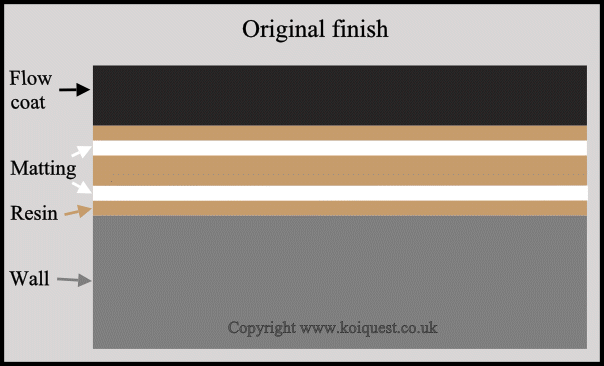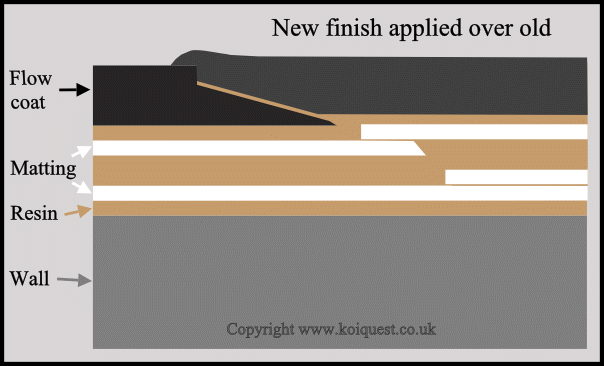Page 1 of 1
fibreglass
Posted: Thu Sep 29, 2011 8:02 pm
by tucker81
when i extended my pond, i didnt re fibreglass the full pond, we just glassed the extension and 500mm onto existing. ive notice that some of the flow coat has been turning up in my filter so just looked and there seems to be some flaking off, will it be ok and should i do anything with the bits that are starting to flake off worried about the fish catching themselves
tom

Re: fibreglass
Posted: Thu Sep 29, 2011 11:29 pm
by Brockp
Hi Tucker;
Bob is your man on FG and I am sure will give you expert advice,
Peter
Re: fibreglass
Posted: Fri Sep 30, 2011 8:15 am
by Glenn
Hi, like Peter says pm Bob, he will sort you out,
Glenn
Re: fibreglass
Posted: Fri Sep 30, 2011 11:59 am
by Manky Sanke
Tom,
As the other guys have said, Bob will help you, but for the information of anyone else looking in, once the original flow coat has cured it's difficult to get more flow coat to adhere to it. This is why the new finish is curling up and flaking off. The surface of the old flow coat has to be prepared by sanding or grinding it back.
Perhaps Bob can elaborate for future information.
Re: fibreglass
Posted: Fri Sep 30, 2011 9:15 pm
by Bob Hart
Its just the flowcoat which has been applied onto previous flowcoat, which has not been keyed up properly. Flowcoat contains wax which comes to the surface when the flowcoat is curing, nothing sticks properly to wax, so it's eventually come off.
Re: fibreglass
Posted: Fri Sep 30, 2011 9:50 pm
by Manky Sanke
Bob,
On another forum someone said that if you grind away the surface of the flow coat quite hard, you can get a surface that resin, (and the matting), will adhere to. Then, if you apply the flow coat over the resin in the normal way, it gives the required water proof finish. I tried something like that when I modified a filter bay that had been fibre-glassed.
For about an inch, I ground back to the matting, then for another inch I ground back about half way through the thickness of the flow coat. Then I resined the new matting to the old but painted the resin out over the ground back flow coat. Once that had cured, I sanded everything down and applied the flow coat.
At the edge where the new flow coat met the surface of the old, I overlapped the new over the old by literally a few millimeters. I didn't "feather it out" because that would have meant putting a thin coat of new over the old and I thought that might be where the peeling back would start. By only overlapping by a few millimeters and by leaving it fairly thick at that point, it set to a thick ridge that doesn't seem as if it would be thin enough to peel or flake.
Anyway, that was the theory. I picked and scratched at it before I refilled and it looked like a good job. And that was a whole three months ago and it still looks to be a sound join. Jog my memory in a couple of years time and I'll tell you whether it lasted.

Re: fibreglass
Posted: Sat Oct 01, 2011 12:52 pm
by Manky Sanke
Here are some diagrams to show how I extended the original fibre-glass.
The original finish.

- Fibre-glass repairs original.gif (21.72 KiB) Viewed 3796 times
After grinding back.

- Fibre-glass repairs ground back.gif (24.54 KiB) Viewed 3796 times
The finished job with the new matting overlapping the old to ensure strength.
The new resin painted thinly onto the ground-back surface of the old flow coat to provide a good key for the new flow coat.
The new flow applied to the new resin as soon as it is cured as is usual, and taken slightly onto the surface of the old flowcoat to provide a ridge that won't peel back.

- Fibre-glass repairs new finish.gif (27.36 KiB) Viewed 3796 times
Hope that helps.
Re: fibreglass
Posted: Sat Oct 01, 2011 1:24 pm
by tucker81
cheers for the info guys, ill keep an eye on it
tom

